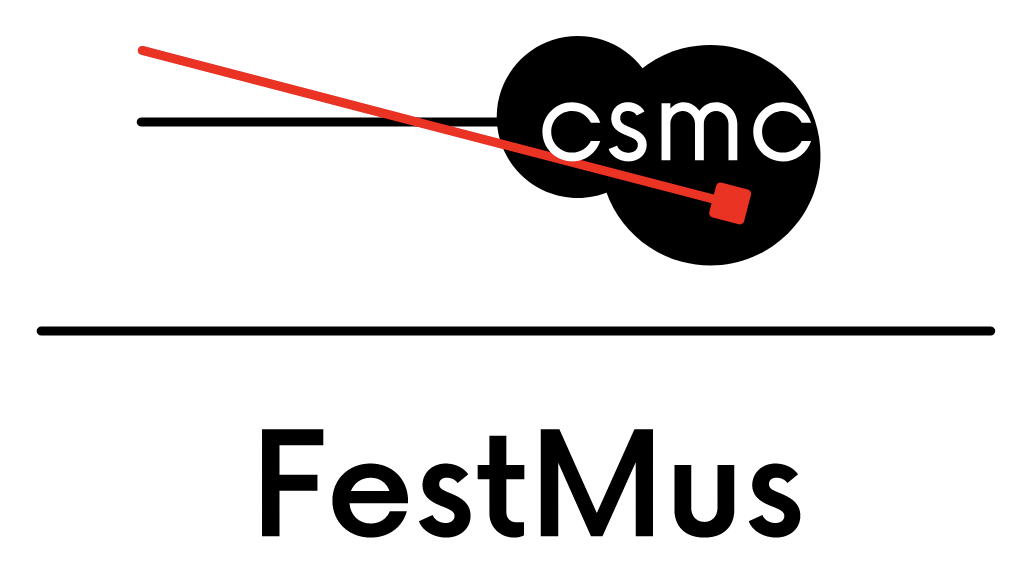CONCERT PROGRAM
“Trencadís”2014 by Miguel Angel Berbis
for symphonic and electronic band
“Pinzellades” by Juan Antonio Serrano, for symphonic band and electronics (world premiere)
“Wait of the World” by Stephen Melillo for symphonic band
“La Topa” concert for brass quintet and symphonic band by Juan Vázquez (world premiere)
M5 Mexican Brass: brass quintet
Marcel Ortega i Martí: Conductor
This concert is made with the grant “MEGA” (Mexico a Escena, Artistic Groups 2021), a project supported by the System of Support for Creation and Cultural Projects (SACPC)
PROGRAM NOTES
“Trencadís”2014 by Miguel Angel Berbis
For symphonic band and electronics
The “trencadís” was a decoration technique widely used by the architects of Catalan modernism. In this musical work, the “trencadís” is used as a concept around how we hear and perceive the Nature that surrounds us and the people who live in this Mediterranean area
“Pinzellades” by Juan Antonio Serrano
The idea of “Pinzellades” is inspired by two well-differentiated pictorial styles: chiaroscuro, which seeks contrast between illuminated and darkened elements, and pointillism, which recreates images using different gradients of dots.
The work seeks to be nourished by these two techniques and apply them to musical parameters, chiaroscuro being long, calm and dense textures, and pointillism, passages of a fast and hasty nature.
“Wait of the World” by Stephen Melillo
demands a commitment to the designated orchestration. The need for the expressive exceeds the technical demands of the work.
Each passing measure depicts Man’s climb through the ages. An ancient architectural code based upon the architecture of the Great Pyramid at Giza reveals the ascent of Humanity through otherwise dark times. The trumpet heralds the new Millennium… where the children shall lead. Still, we await something which has already happened… perhaps something within us. In the final movement, every tonality is explored, save one. Finally, we reach that new key, a symbol of what we wait for while carrying on our shoulders… the weight of the world. Beyond these words, it is difficult for me to describe what for me, can only be said as Music. In this work, over 11 hours of Music called STORMWORKS reaches its temporary conclusion… and its new beginning. Great Music recreates the past, reveals the ever-present, and plots the Human Adventure soon to unfold.” -SLM 1997.
This piece is for symphonically minded Musicians of superior ability. It was commissioned by Major Maurice Hamers and The Marine Band of the Royal Netherlands Navy.
“La Topa” Concert for brass quintet and symphonic band by Juan Vázquez
At the end of December 2022, the metal quintet M5 The Mexican Brass sought me out to request the composition of a work that had the format of a concert. A peculiarity of the work requested was that the solo component of the concert was the same quintet. Another important feature was that the quintet would not be accompanied by an orchestra, but by a symphonic band. In addition, I was invited to incorporate elements of traditional Mexican music into the work. Faced with these three requirements, the solution that seemed most solid to me was that of “la topa”.
In the towns of Mexico, perhaps with more emphasis on those along the Pacific coast, there is a strong tradition of bands. It is something that came with the old world. Like everything that arrived from the other side of the Atlantic, in Mexico it acquired a distinctive flavor that today constitutes, along with many other things, a component of Mexican music. Thus, the village bands, whose musical tradition is more of a community than an academic matter, embrace an enormous diversity of repertoire that ranges from traditional sounds (such as basset, escalfà, mixteco, mixe, etc.), to works from the “classical” repertoire, composed by Verdi, for example, and adapted to the various endowments that can be found in the communities of the Mexican people. This repertoire is sometimes shown in topes, which are nothing but gang duels and sometimes more than duels, confrontations between three, four or more bands. At the top, the band that has the most repertoire will prevail, that can withstand the adversities of the weather and fatigue and even the party, in its alcoholic invitation; the band that plays the fastest, has the most virtuosic musicians and the most records arrive, and sometimes the best dressed band. Everything can be brought to competition.
Around this idea of the top I allowed myself to build this short concert, or concert fantasy, since I did not limit myself to trying to recreate the confrontation between two couplings, but rather, taking advantage of the difference in dimensions between a brass quintet and a symphonic band, I allowed myself to fantasize around ideas surrounding heroism and the strife between dark and light forces. The band represents a pernicious entity that stalks a town; some dark spirit that would do well to throw away. The quintet, on the other hand, represents these heroes of the town, musicians, who will seek to expel the dark entity. Only the percussion, and more particularly the tarola (as we say in Mexico on the box), which is almost a sixth soloist, will be like an arbitrator or mediator who oversees an “honorable” duel.
The work begins in a hazy and confusing environment until the soloists appear, investigating how to take charge of it. Soon the two forces begin to argue and confront each other and the tarola to bring order, leading to the beginning, as such, of “la topa”. Both assemblies will show their virtues and abilities. After several coincidences, the quintet will understand that they need to do something more elaborate, which is why they propose an escape as a “more complex” spell against the dark spirit of the band. It is the escape that gives them victory in this kind of musical exorcism and what allows them to take the work to more joyful and festive tones, that is to say: to the resolution of the conflict and the arrival of an agreement.
JUAN ANTONIO SERRANO
He was born in Alcanar in 1997. At the age of five, he began his studies musicals at the Municipal Music School of Alcanar, where one more year later he begins the studies of saxophone and piano. He became part of the Municipal Band of Alcanar at the age of twelve, at the same time that he continues his musical studies with Juanjo Villarroya, professor and current director of EMMA. Once he finished high school and middle school, he entered the Superior Conservatory of Music “Salvador Seguí” of Castelló, studying the mode of composition. Expand your studies with taught composition courses and seminars by Bert Appermont, James Barnes, Ferrer Ferrán, José Manuel López, Carlos Fontcovert; and directing courses with Carlos Garcés. Lately, it has participated in the composition residence of the Coves de Vinromà de la mà by the composer and percussionist David Moliner and has won the 3rd prize in the competition for young composers organized by the SGAE foundation. He is currently finishing his composition studies at the CSMC, at the same time who attends the “Mentoring program” of the Tinguely museum in Basel, under the tutelage by David Moliner.
JUAN VÁZQUEZ
Mexican composer, lawyer, teacher and conductor, originally from La Piedad, Michoacán; founder and chief conductor of the Tzintzuni Philharmonic Orchestra in the city of Morelia. He began his piano studies at an early age, with maestro Saúl Heredia, to continue later as a student of maestros Mario Quiroz and Miriam Pérez Fleitas at the Conservatorio de las Rosas. In 2006 he began his studies in composition independently with Jorge David García Castilla, until 2011, the year in which he entered the Escuela Libre de Derecho to train as a lawyer. In 2016 he continued his musical and composition studies with the teacher María Antonieta Lozano to later continue in a self-taught way.
He is the author to date of 46 musical works. His work has been performed at various festivals and forums, including the Morelia Music Festival, “Miguel Bernal Jiménez”, the Aires de la UNAM Festival, the UNAM International Piano Festival and the “Alfonso Ortiz Tirado” Festival. “, to name some of them. In 2021 he was the winner of the first prize in the “Arturo Márquez” Chamber Orchestra Composition Contest, with the work “Nocturno del Pacífico”, inspired by the traditional sones of the Mexican states of Oaxaca, Guerrero and his native Michoacán. As a conductor, he has worked, over the course of three years, in six concert seasons as chief conductor of the Tzintzuni Philharmonic Orchestra. He has participated as a guest conductor with the Mexico City Chamber Orchestra, the Oaxaca Camerata, the Sonora Philharmonic Orchestra, and the Michoacán Symphony Orchestra.
COL·LABORADORS | COLABORADORES | PARTNERS
![]()

![]()
![]()





